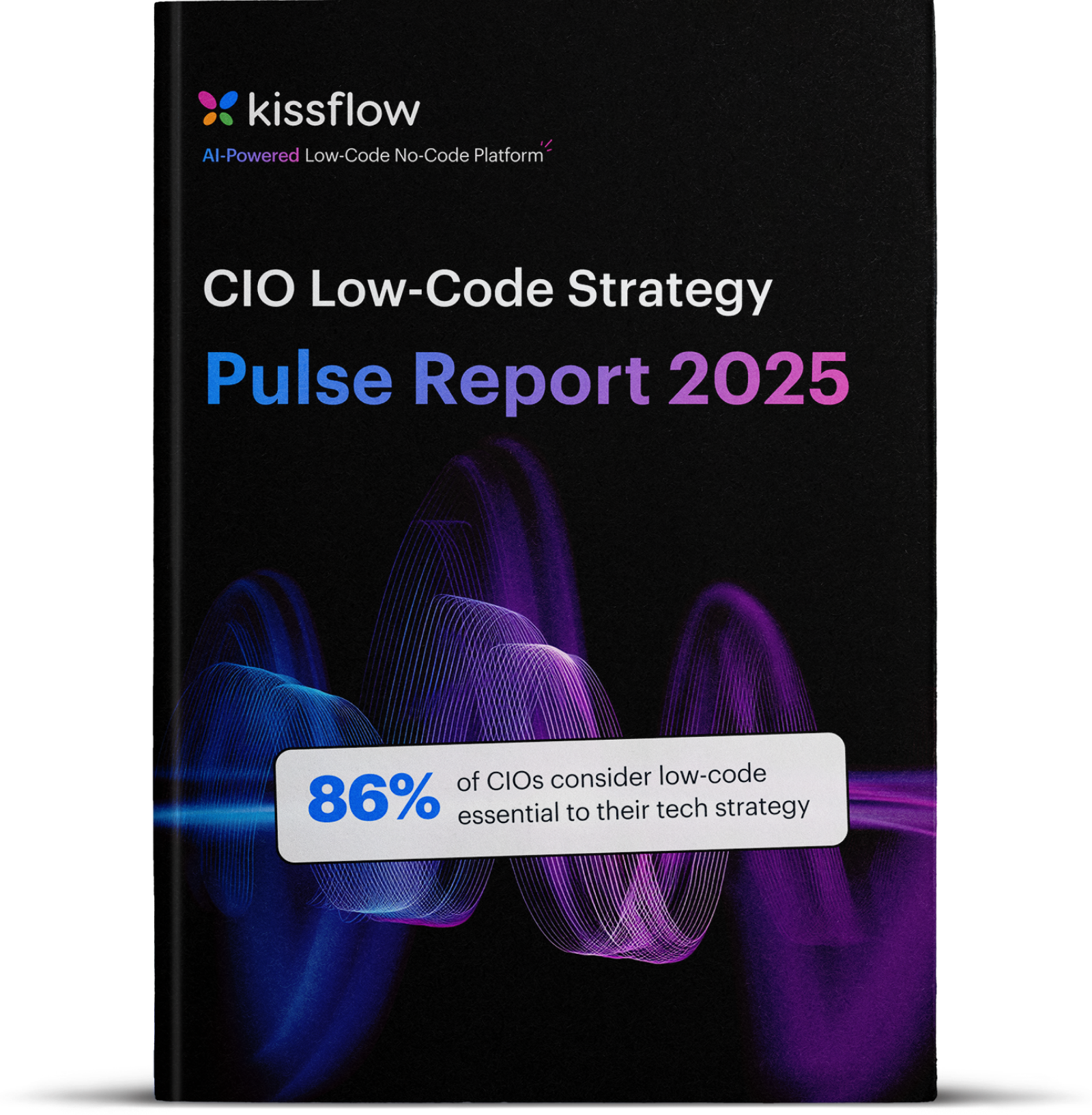
- >
- BPM Software >
- Business Process Transformation - An Ultimate Guide for 2026
Business Process Transformation - An Ultimate Guide for 2026
As part of their digital transformation strategies, enterprises reevaluate their technological needs and digitize their internal operations to remain competitive, sustainable, and resilient.
But CIOs constantly fine-tuning their digital initiatives also need to remember that for transformation to be truly impactful and successful, the focus should be on business process transformation.
A well-planned business process transformation involves aligning people, technology, and culture to fundamentally change how enterprises operate, meet new business goals, and deliver value to new customers.
What is Business Process Transformation?
Business process transformation is the comprehensive redesign and restructuring of business processes to achieve significant improvements in operational efficiency and agility. It can be driven by factors such as cost reduction, improved customer satisfaction, or increased competitiveness. A strong process transformation framework helps guide this reengineering of critical processes, functions, workflows, tools, and technologies to meet business demands and accelerate time-to-market.
Business process transformation is the comprehensive redesign and restructuring of business processes to achieve significant improvements in operational efficiency and agility. It can be driven by factors such as cost reduction, improved customer satisfaction, or increased competitiveness. A strong process transformation framework helps guide this reengineering of critical processes, functions, workflows, tools, and technologies to meet business demands and accelerate time-to-market.
Business Process Transformation involves radically changing the elements of your processes to meet new business goals. Usually, these new goals are centered around a new digital transformation implementation.
Most companies engage in business process transformation when they need to make a drastic update to existing processes. Using this process transformation methodology, you can modernize your processes, incorporate new technology, save costs, and better integrate your core systems.
Business process transformation is part of the larger concept of business process management (BPM).
"The entire concept can be boiled down to a simple formula: new business demands + updated technology systems + talent + culture change = business process transformation. To describe an organizational transformation as purely digital, you neglect and even negate the necessary culture shift required to sustain systematic change"
- Daragh Mahon, Forbes Councils Member.
Steps in Business Process Transformation
Business process transformation follows similar steps to business process management but attempts to make bigger and more drastic changes.

1. Identify the goals of the transformation
Are you primarily trying to upgrade systems? Incorporate new technology? Adapt processes to a new organizational structure? What has caused the need?
2. Establish baseline metrics
Collect the data needed to show that your business process transformation will be successful. Think through cost, time, number of errors, and other metrics you can measure.
3. Bring in all stakeholders
Ask all those involved in the process for their feedback on what worked well in the prior process and what they expect out of the new one.
4. Map out the best scenario
Using a diagramming tool, create the ideal workflow path including human and system tasks that need to take place.
5. Implement in a testing environment
Use a BPM tool to create a mock process and see how it runs between people and data.
Learn More: Best BPM Tools
6. Set live and monitor
Include small teams at first to the new process and closely monitor the progress and any changes that need to happen for the process to succeed.
Learn more: Process automation solutions
Challenges in Business Process Transformation
As with any huge paradigm shift, business process transformation creates a number of challenges that must be resolved in order to succeed.
1. Weak sponsorship engagement.
Throughout the entire lifecycle, from inception to development and deployment, you’ll need strong sponsorship from a person who will not only champion your requirements but also be patient enough to wait for the results to manifest. Without strong sponsorship, as emphasized in any effective process transformation framework, it can be more than a challenge to complete the transformation process.
2. Change in management practices
Constantly changing management practices another challenge for business process transformation. As inefficient as your old process might have been, you will always have people who prefer “the way we used to do it”. As a part of implementing a business process transformation, you need to use good change management principles to bring everyone along.
3. Integration challenges
Integration challenges can be significant in business process transformation. If you don’t choose the right BPM platform, you maybe very limited in what you can integrate with other software. You may realize from the beginning how challenging it will be to link to different platforms.
4. Missing key objectives
To miss key objectives is a big challenge. Many business process transformation efforts end up only digitizing a process and have no noticeable effect on the efficiency of the process. Don’t settle for a dressed up version of your old business process. Make sure your successes are clearly defined.

The Ultimate Buyers guide to BPM Software
Unlock the Power of Comprehensive BPM Tools: Scale, Succeed, and Stay Ahead
Thank you for downloading!
When Should You Apply Business Process Transformation?
You should apply business process transformation in the following cases:
- When an existing process is not meeting the demands of the business
- When you have a significant number of errors in a process
- When you’ve updated the surrounding technology
- When your existing corporate organization no longer makes sense
5 examples of Business Process Transformation in action
Here are five business process transformation examples that show how organizations improve efficiency, cut costs, and enhance customer experiences. These real-world cases highlight how companies use technology to redesign core processes and drive measurable outcomes.
1. Transforming invoice processes
Invoice processing is one of the most delicate and critical workflows in organizations, desperately needing transformation. In one survey of businesses that process at least 350,000 invoices annually, errors led to up to 32 percent of late payments from customers and about 36 percent of supplier calls. A solid process transformation framework helps address these issues by targeting each checkpoint—ledger entry, expense approvals, invoice approvals, records, payment schedules—for automation and optimization.
2. Onboarding process transformation
Whether it’s new customers using your service for the first time or employees joining your team, the onboarding process is the first real contact new people will have with your business. Onboarding inefficiency can increase the churn rate of your business and also impact the employee experience in the long-term.
With onboarding process transformation, companies can introduce digital onboarding portals, e-learning modules, and automated documentation verification. These channels accelerate onboarding, saving time and enhancing the overall experience.
3. Transformation of contract processes
The contract management process can be quite complex and time-consuming. Then there are the complexities of getting signatures and approvals, managing governance and security, ensuring proper storage, and retrieving contact information when needed.
Transforming contract processes is one of the key aspects of business process transformation. It involves using a contract lifecycle management (CLM) software and other tools to automate creating contracts, negotiating terms, getting approvals, and monitoring contracts.
Digitizing and automating contract processes can reduce the time spent on creating contracts and improve efficiency. It also makes it easier to harness reliable data from contracts to deliver actionable business insights.
4. Transforming the purchase order process
Procurement is a complex multi-step process comprising several checkpoints and approval tasks. Organizations using manual workflows and spreadsheets to manage purchase order processes often struggle with inefficiencies. According to a recent study, manual purchase order processing can cost organizations up to $506.52 per purchase order.
The purchase order process can be optimized by implementing an e-procurement system for automating various tasks and approval checkpoints. It allows organizations to centralize purchasing, control spending, and negotiate better terms with suppliers.
Transforming the purchase order process helps gain greater visibility into procurement activities, reducing costs and improving the overall efficiency of your supply chain.
5. Transformation of logistics workflows
Controlling the flow of goods and services is one of the most complex but vital functions for any business that wants to operate profitably. Transforming logistics workflows involves implementing digital solutions to ensure real-time tracking of routes, inventory management, and route optimization.
Organizations can minimize transportation costs and reduce delivery times for incoming and outgoing deliveries by streamlining their logistics workflows.
How to measure your business process transformation strategy’s success
Business process transformation is a huge undertaking that often requires long-term efforts to ensure success. During this period, success has to be tracked incrementally to ensure you’re on track at every implementation stage. There are different metrics that can measure the success of your transformation strategy.
Some of the most basic BPT metrics include:
- Improvements in customer experience and satisfaction
Customers are at the receiving end of every business process transformation. Consequently, their overall experience and satisfaction at the end of each business interaction reflect the effectiveness of your transformation strategy. - Revenue attributed to new processes
It refers to the revenue you have earned from implementing your transformation strategy. An increase in financial performance due to business process transformation is often an indication of successful transformation. - Enhanced operational efficiency
Successful business process transformation increases the overall operational efficiency of your organization. It can be measured in the form of time spent on tasks, cost, and the ratio of work input to output. - Increased employee productivity and engagement
One of the top goals of business process transformation is to empower employees to create new business solutions that can enhance their productivity. Taking direct feedback from employees and measuring metrics such as the task completion rate can determine the effectiveness of your transformation efforts. - New leads and customer conversions
It is a particularly important metric for customer-facing processes such as sales, marketing, customer onboarding, and so on. Successful business process transformation increases the number of leads, customer conversions, and long-term retention.
Why should organizations care about business process transformation?
Keeping up with changing market trends is a constant for every business, regardless of its current size and scope. Forward-thinking businesses rely on a strong process transformation framework to drive innovation, prevent stagnancy, and reach new growth milestones.
Redundant business processes can be quite expensive. Transforming them cuts costs and increases profits in the long run.
Vibrant Emotional Health is the non-profit behind the National Suicide Prevention Lifeline, which is one of the largest providers of suicide prevention services in the world.
The company was facing significant difficulties in managing approval workflows manually. Executives and senior managers had to be physically present for all approvals, leading to delays. The organization used manual forms and document signing software like DocuSign, which was limited in scope and quite expensive.
As a growing organization, Vibrant needed to transform its approval process to allow executives to access payment and purchase requests remotely and approve them.
By adopting Kissflow for permission requests and approvals, Vibrant cut the time spent on filling forms by more than half, drastically reducing the overall cycle time for their requests and approval processes. With the significant increase in efficiency, Vibrant is looking to extend Kissflow’s use to other key processes and workflows within the organization.
Take your first step towards business process transformation
Kissflow is a low-code platform that offers industry-leading business process transformation for enterprises. Using the low-code solution, you can digitize and optimize existing processes or quickly create new ones from scratch with little to no coding. By leveraging process automation software, businesses can unify tasks, approvals, and data flows into a single system. This makes processes more transparent, measurable, and adaptable to changing organizational needs.
Kissflow also offers advanced data analytics that helps you generate reports and get insights about your processes.
Solve your workflow challenges with Kissflow and optimize your team's productivity.
Frequently Asked Questions (FAQs)
1. What are the steps in business process transformation?
Steps in business process transformation include establishing a transformation vision aligned with strategy, documenting current processes to understand pain points, designing future-state processes, developing implementation roadmaps, establishing governance mechanisms, building necessary capabilities (people, technology, data), implementing changes through controlled rollouts, and measuring results against baseline metrics.
2. How does AI drive business transformation?
AI drives business transformation by enabling predictive rather than reactive operations, creating personalized customer experiences at scale, automating complex processes previously requiring human judgment, extracting actionable insights from massive datasets, enabling natural language interfaces that improve accessibility, and continuously optimizing operations through machine learning that identifies improvement opportunities.
3. What industries lead in process transformation?
Industries leading in process transformation include financial services modernizing customer journeys, healthcare improving patient experiences, manufacturing implementing smart factories, retail creating omnichannel experiences, and telecommunications deploying next-generation infrastructure and services.
4. What are common challenges in digital transformation?
Common challenges in digital transformation include organizational resistance to change, legacy system integration difficulties, data silos preventing unified views, inadequate digital skills among employees, security and compliance concerns, unclear ROI measurements, and leadership misalignment on transformation priorities. Cultural factors often present greater challenges than technological ones.
5. How can businesses successfully transform workflows?
Businesses successfully transform workflows by establishing clear transformation objectives aligned with strategy, securing executive sponsorship, involving employees throughout the change process, implementing appropriate technology solutions, redesigning processes before automating, providing adequate training and support, measuring results against baseline metrics, and creating mechanisms for continuous improvement.
6. What makes business process transformation different from simple automation?
Transformation redesigns the process itself—removing redundancy, changing routing logic, and aligning it to outcomes. Automation alone just digitizes existing steps without improving them.
7. When should enterprises pursue full transformation?
When processes are slow, fragmented across teams, or misaligned with business goals. Incremental fixes won’t solve structural issues.
8. How does BPM enable transformation at scale?
By providing modeling, automation, monitoring, and iterative optimization in a governed system.
Related Articles











%20(1)%20(1).png?width=1997&height=1800&name=The%20ultimate%20buyers%20guide%20to%20BPM%20(1)%20(1)%20(1).png)
